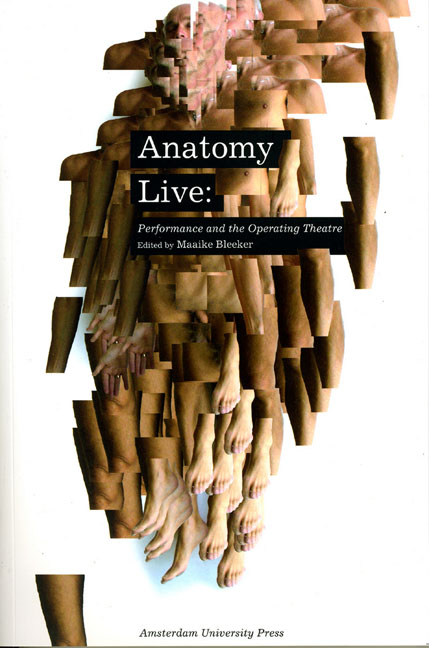Book contents
- Frontmatter
- Contents
- Acknowledgements
- Prologue - Men with Glass Bodies
- Introduction
- Performance Documentation 1: Holoman; Digital Cadaver
- Digital Cadavers and Virtual Dissection
- ‘Who Were You?’: The Visible and the Visceral
- Performance Documentation 2: Excavations: Fresh but Rotten
- The Anatomy Lesson of Professor Moxham
- ‘Be not Faithless But Believing’: Illusion and Doubt in the Anatomy Theatre
- Performance Documentation 3: De Anatomische Les
- Of Dissection and Technologies of Culture in Actor Training Programs – an Example from 1960s West Germany
- Ocular Anatomy, Chiasm, and Theatre Architecture as a Material Phenomenology in Early Modern Europe
- Performance Documentation 4: Camillo – Memo 4.0: The Cabinet of Memories – A Tear Donnor Session
- Martin, Massumi, and the Matrix
- Performance Documentation 5: Sensing Presence no 1: Performing a Hyperlink System
- ‘Where Are You Now?’: Locating the Body in Contemporary Performance
- Performance Documentation 6: Under My Skin
- Anatomies of Live Art
- Performance Documentation 7: Crash
- Restaging the Monstrous
- Delirium of the Flesh: ‘All the Dead Voices’ in the Space of the Now
- Performance Documentation 8: Körper
- Operating Theatres: Body-bits and a Post-apartheid Aesthetics
- Index
Digital Cadavers and Virtual Dissection
Published online by Cambridge University Press: 10 February 2021
- Frontmatter
- Contents
- Acknowledgements
- Prologue - Men with Glass Bodies
- Introduction
- Performance Documentation 1: Holoman; Digital Cadaver
- Digital Cadavers and Virtual Dissection
- ‘Who Were You?’: The Visible and the Visceral
- Performance Documentation 2: Excavations: Fresh but Rotten
- The Anatomy Lesson of Professor Moxham
- ‘Be not Faithless But Believing’: Illusion and Doubt in the Anatomy Theatre
- Performance Documentation 3: De Anatomische Les
- Of Dissection and Technologies of Culture in Actor Training Programs – an Example from 1960s West Germany
- Ocular Anatomy, Chiasm, and Theatre Architecture as a Material Phenomenology in Early Modern Europe
- Performance Documentation 4: Camillo – Memo 4.0: The Cabinet of Memories – A Tear Donnor Session
- Martin, Massumi, and the Matrix
- Performance Documentation 5: Sensing Presence no 1: Performing a Hyperlink System
- ‘Where Are You Now?’: Locating the Body in Contemporary Performance
- Performance Documentation 6: Under My Skin
- Anatomies of Live Art
- Performance Documentation 7: Crash
- Restaging the Monstrous
- Delirium of the Flesh: ‘All the Dead Voices’ in the Space of the Now
- Performance Documentation 8: Körper
- Operating Theatres: Body-bits and a Post-apartheid Aesthetics
- Index
Summary
Anatomical dissection is considered an essential ingredient of medical training. By looking at and cutting into dead bodies, future doctors learn to distinguish between healthy and diseased tissue in living bodies, while also gaining an understanding of the three-dimensional shape of organs, veins, and bones. Anatomical dissection literally means to separate the body into pieces; this systematic disassembling of the physical body is justified because it results in an entirely new body – a body of knowledge. More generally, the confrontation with human cadavers functions as an important initiation rite for medical students: not until they have familiarized themselves with the face of death can they embark on a long educational journey that ends with a solemn dedication to life – the Hippocratic oath. Anatomy, from the outset, has been surrounded by sacral and secular symbolism; to this very day, the medical specialty has a morbid public image, associated as it is with the smell of decay and the aura of death.
Cadaver dissection does not provide the only occasion for students to become acquainted with human organic architecture. Anatomical illustrations help them conceptualize the form and structure of various organs before they actually touch them. Without these two-dimensional representations, a thorough understanding of the body's physiology would be inconceivable. Ever since the fifteenth century, knowledge derived from close observation of cutup cadavers has been recorded in drawings and anatomical atlases. To convey their empirical findings, anatomists depended on the precision and craft of their illustrators. Accordingly, anatomical illustration is commonly viewed as mediated knowledge. Even the most sophisticated anatomical drawings, like those by Leonardo da Vinci and Andreas Vesalius, were considered a derived form of knowledge – idealized representations of real bodies.
From the early days of anatomy, then, anatomical training has relied on a combination of learning to dissect bodies and learning to read anatomical illustrations. But this basis has become too limited, argue the initiators of the Visible Human Project (VHP), who in the 1990s developed a new instruction tool that will purportedly revolutionize anatomy (Ackerman, 1999, pp. 667-70).
- Type
- Chapter
- Information
- Anatomy LivePerformance and the Operating Theatre, pp. 29 - 48Publisher: Amsterdam University PressPrint publication year: 2008



